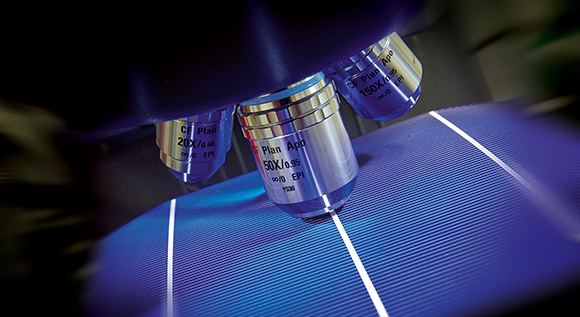Setting new records: getting more out of the sun
Generating more electricity from the same amount of sunlight without higher production costs – that is one of the key aims of research and development in the field of photovoltaics. Two projects funded by the Federal Ministry for Economic Affairs and Energy have come a little closer to this goal.
 Analysis of highly efficient solar cells. The record module consists of 120 half high-performance PERC solar cells. © Solarstromforschung / SINGULUS TECHNOLOGIES AG
Analysis of highly efficient solar cells. The record module consists of 120 half high-performance PERC solar cells. © Solarstromforschung / SINGULUS TECHNOLOGIES AG
The problem is that even when scientists develop highly efficient solar cells, when the cells are switched together as a photovoltaic module they lose efficiency, i.e. output per area. The 20.2 per cent of sunlight which a new highly efficient module of the Institute for Solar Energy Research Hamelin (ISFH) converts into electricity is therefore a new world record for the efficiency of large-area photovoltaic modules made of crystalline silicon PERC solar cells.
How did they do it? Firstly, the researchers analysed the typical output losses which occur within the individual solar cells and when they are switched together to form a module. Establish the causes, then remedy the problem: to do this the experts studied the details of the production processes and materials used and their interaction. For example, there is an effect called “light-induced degradation”: the sunlight hitting the solar cell activates a material defect, meaning that less electricity can be extracted. The scientists managed to reduce such effects. And that was precisely what the “PERC 2 modules” project funded with approx. €2.2 million by the Federal Ministry for Economic Affairs and Energy wanted to accomplish: high quality and long life.
The new figure of 20.2 per cent beats the previous module efficiency record of 19.5 per cent. Both figures apply to modules which – rather than existing in a purely laboratory environment – are manufactured on an industrial scale, so that the findings can be quickly transferred into the manufacturing process.
Another German world record at solar cell level
Another world record was achieved at the individual cell level. At 22.04 per cent electricity output from an advanced PERC solar cell, Solarworld AG has beaten its own record from mid-2015 of 21.7 per cent – the aim is to get past 22.5 per cent by the end of 2017. This new record was also achieved as part of the HELENE research project, which is funded with about €9.9 million from the Federal Ministry for Economic Affairs and Energy as part of the “R&D for photovoltaics” funding initiative.
Successes like the two world records show that the funding is boosting the competitiveness of Germany’s photovoltaic research and industry. And the energy transition benefits from the new technologies and innovations which are demonstrably being fostered by this research and development.

